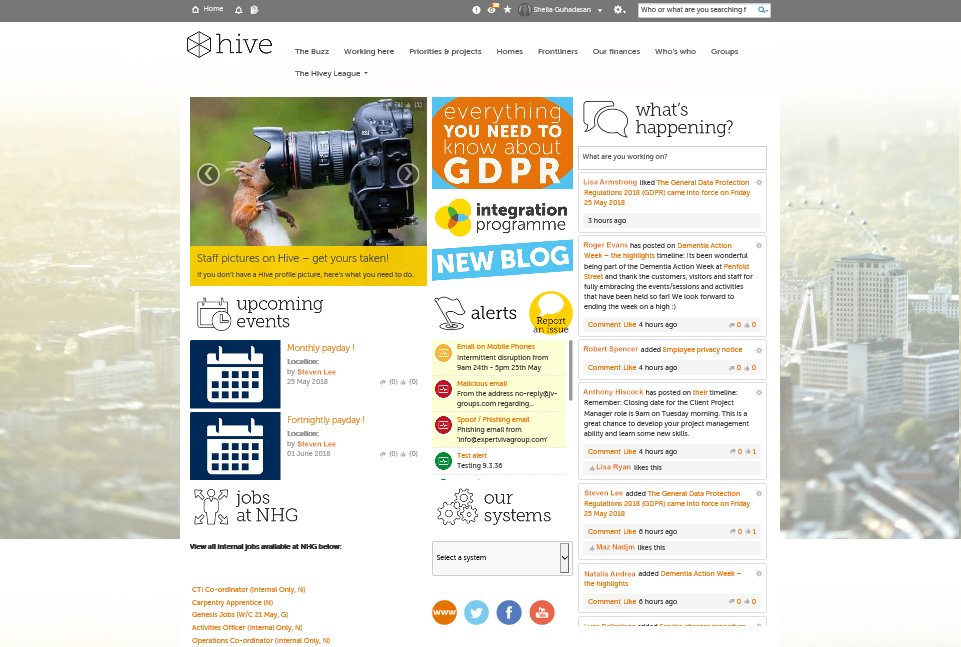How social tools can save your change communications

While change is often inevitable for companies chasing success, it can be the bringer of chaos and mayhem for employees. To combat this, we must bridge the distance between leaders and employees. Thankfully, social tools have become some of the most potent change communication tools.
If you remember your last major organizational change, you also recall that sense of uncertainty you felt as a result. When your role in the organization depends on the views and goals of management, surprises are not always welcome.
Change always has the potential to stir doubt in your staff. Will they need to change offices? Will there be layoff announcements ? What does this mean for their team?
While you cannot always stop the doubts brought on by change, you can work to assuage them. The rise of social tools in the digital workplace has created opportunities for greater collaboration and stronger change communication.
In fact, a Weber Shandwick study revealed that 55% of respondents who had gone through a change event at work said they wished their employer offered more digital and social engagement.
Employees already spend nearly three hours per day on social platforms, and many employers have begun to integrate social tools. This is the perfect time to leverage social applications as your change management tool.
Here are a few ways social tools can be the saving grace of your organization.
Stop the spread of negativity
The most significant issue with a change in an organization is the rapid pace at which pessimism arises. Negativity spreads like wildfire and the cause is a lack of transparency.
Keeping your employees in the dark is a recipe for disaster. One that has the potential to spiral way out of control. It is easy to fear something you know nothing about: but stopping that fear is just as easy.

Transparency is the key. Your employees are the crux of your organization, so keeping them in the loop should be almost instinctual. An open two-way dialogue should be available across all levels, and social tools can do just that.
An HBR survey shows that 82% of employees think that social media can improve work relationships and 60% believe social media can support decision-making processes. This mentality alone shows the potential social applications such as forums and surveys can have on increasing positivity in your organization.
14 steps to great internal communications
A successful social tech tool will work alongside good, open management to ensure employees feel informed, motivated and positive about the upcoming changes. This, in turn, translates into a positive employee experience, one that spreads among the organization and staff members.
Social tools via your intranet open up communication from both the top and bottom, as well as support communication across teams and departments. Developing a space to support sharing information, executive level and beyond, can establish a sense of trust for any organization going through a change. This will ultimately add value for both employee and management in the long run.
Break down potential silos
Statistics place M&A success at a rather low percentage (70% to 90% of mergers fail). Other organizational changes fare no better, and retention rates suffer in the process. Needless to say, change is hard on everyone. But those hit the hardest are your staff.
For instance, in times of change such as merger, acquisition or team changes, a divide between current and new staff is expected. What begins as a pure awkwardness between strangers can quickly develop into siloed teams separated by strategy, goal and implementation methods.
However, the goal of any organizational change is to improve the entirety of the organization, not just any single group.
With social tools, you can efficiently remove the ‘us vs. them’ mind frame and create a culture where collaboration and communication reign supreme.
Deploying an intranet is a fool-proof way to strengthen social ties within your workforce and deliver a unified message to all.
With tools such as blogs and employee stories shared via Instagram, Twitter or your own intranet, employees can unify. Sharing experiences has the power to bring together those who may have encountered the same, leading to harmony within your staff.
Customer Notting Hill Genesis (NHG) did a great job of this earlier this year. NHG utilized Interact technology on their intranet after merging Notting Hill Housing (NHH) and Genesis Housing Association. Upon joining, employees disregarded the legacy intranet, reinforcing the silo nature and creating a disjointed culture.
In response to these challenges, Notting Hill Genesis created their intranet, Hive. They used features like their ‘Take the Hive tour’ prepped with ten handy top tips to get staff started on Hive including how to set up their profile, search the people directory, follow colleagues and join groups they may be interested in.

Hive improved collaboration among employees by making staff members feel more comfortable introducing themselves to other colleagues. This openness to collaboration celebrated the diversity of their staff and gave an inside look into their colleague’s work lives.
Social tools via the intranet allowed for a deeper engagement and fostered change communication that encouraged collaboration.
Bridge the gap between leadership and their teams
Too many executives think only of social media when it comes to social, but executives need to look at the bigger picture. During change, employees want to hear from their leaders more than anyone.
Studies show that only 21% of employees who have recently gone through change feel their employers value their ideas and opinions. When social systems fail, one of the main reasons is the lack of leader engagement. Convert your leaders to the wonders of social tools.
Managers can utilize social tools more efficiently than any other group. They can create social groups via apps like Twitter, Facebook, or their own intranet. There, employees are more likely to collaborate, share opinions, and discuss the effects of any ongoing change.
![]()
Change communications means not only sharing a message, but making sure it is received well by all recipients. However, getting your leaders involved can be a challenge.
According to another study, 73% of employees said that CEO social participation gave more employees the chance to communicate directly with the CEO, while 72% said social engagement helped the CEO understand what was happening inside the company. In this way, a leader can use social tools and groups to counter turnover intentions directly.
Recognizing the issue before it becomes a problem is a real accomplishment. One that comes with an inside look at employee mindset.
Add social tools to your change communications by first asserting which platforms your staff uses most. Go to where your people are. Integrate tools like Slack or Yammer where your team feels comfortable exchanging ideas.
This technology can support any transition you may have planned and even garner staff ideas you may never have thought of. How leaders approach change communications and internal social tools is the next frontier for organizational change.
Building a connected digital workplace
Conclusion
Social tools are quickly becoming indispensable to the digital workplace. Proper change communication and social tools encourage transparency, two-way communication, and a more in-depth look into organizational goals.
So, while change itself may be a handful, managing proper communication methods can boost performance, and ensure a smooth transition to success.


